This week I’ve got a great little music theory exercise for you that will help with learning the notes on the neck, some essential arpeggios, the chords within a major key and the circle of 5ths!
The Basic Exercise
For this exercise we will be playing through the chords of the major key in order, both ascending and descending from root notes on one string. We want to try this with all three fingerings for each arpeggio type, in all keys.
This might seem a little tricky at first so let’s work through the exercise in simple steps.
The Major Scale
First of all we have to know our major scale and we have to know it on one string.
So just in case you didn’t know, a major scale is based on a formula of whole steps and half steps or tones and semitones. The formula is as follows:
Whole Step – Whole Step – Half Step – Whole Step – Whole Step – Whole Step – Half Step
This can easily be learned as ‘two whole steps and a half step – three whole steps and a half step’.
A whole step is 2 frets of distance and a half step is 1 fret of distance. So let’s try that C major scale on one string using our formula:

This gives us the notes of C Major: C D E F G A B. If we apply the same formula of whole/half steps working from F we get the F Major scale: F G A Bb C D E. This applies to every major scale.
Learning those notes on one single string can be a huge problem for some bass players that haven’t worked on their fretboard knowledge. So try playing through the scale, saying the notes aloud and focus on how the notes relate to the fret markers.
Play up and down the C Major scale until you have it under your fingers.
Chords Of The Major Key
Every key contains a set of chords starting on each note of the scale. The Major Scale has seven notes and this means every key has a set of seven chords.
The sequence of triad chords in the Major key is as follows:
- Chord 1: Major
- Chord 2: Minor
- Chord 3: Minor
- Chord 4: Major
- Chord 5: Major
- Chord 6: Minor
- Chord 7: Diminished
Applying this set of chords to the C Major key results in the following sequence:
- C Major
- D Minor
- E Minor
- F Major
- G Major
- A Minor
- B Diminished
Basic Triads
In the previous list we encountered 3 types of triad: The Major Triad, The Minor Triad and the Diminished Triad. These chords can be played on the bass as arpeggios (a chord played one note at a time).

These are the most common fingerings but there are many ways to play any arpeggio or scale. We’ll cover some other fingerings for the arpeggios later in this lesson.
Applying The Arpeggios
Now we have some arpeggio shapes, let’s apply them in our exercise. We can play the appropriate arpeggio for each chord working through our scale on one string:

As you can see, this is a great exercise for learning the chords within a key.
The Three Variations
For each arpeggio we’ve covered, there are three different fingerings from any one fret position. We can roughly label these by the starting finger but there are exceptions. The common fingerings are from a root note played with the 1st finger, 2nd finger and 4th finger as follows:
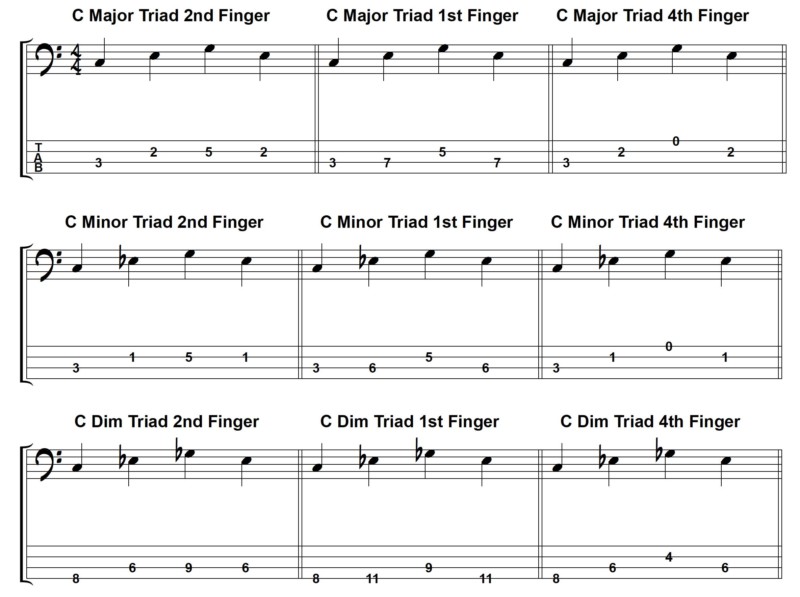
Applying The Three Fingerings
Now we have three patterns for each arpeggio, let’s try the exercise again and use each pattern in turn:
2nd Finger Patterns
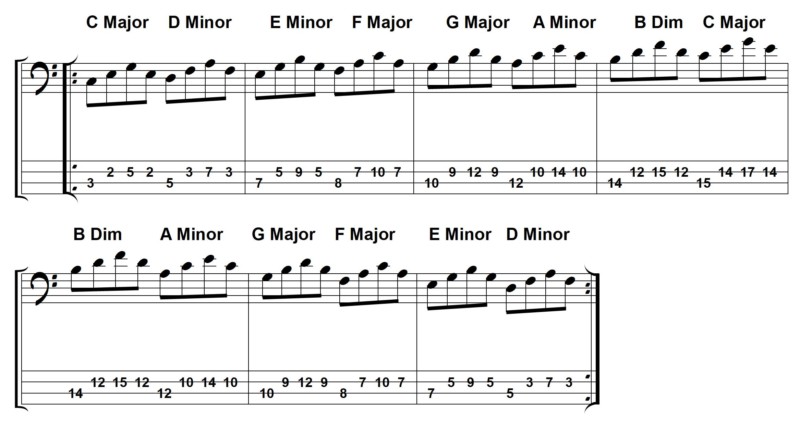
1st Finger Patterns
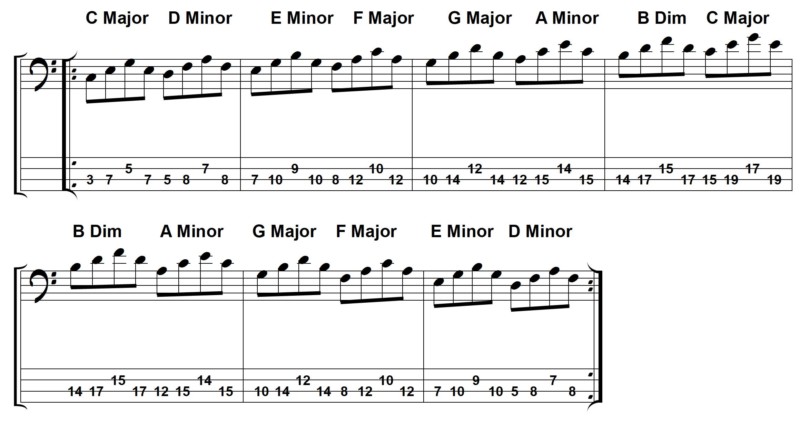
4th Finger Patterns
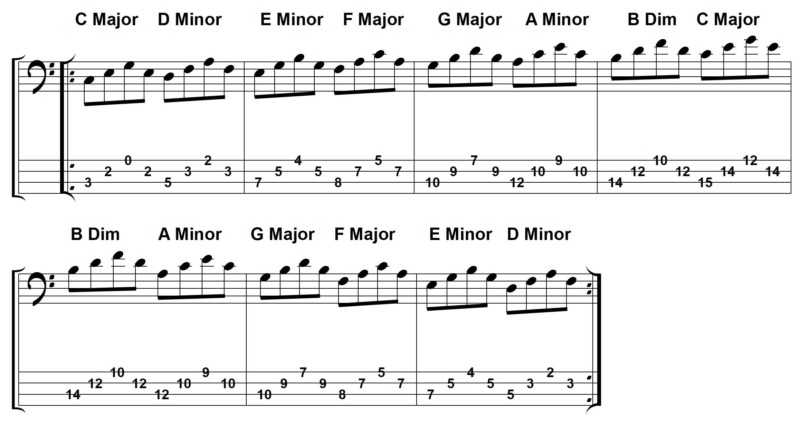
Working Through The Keys
All that’s left now is to work it through every key and this is where the exercise gets tough and really excels.
To play the exercise in a different key, you have to know the notes in the key and be able to see them on the neck. Also, by saying the chords out loud as you go, you’ll learn the pattern of chords in that key. This is really important when developing a knowledge of scales and keys.
We can systematically work through every key by working through the circle of 5ths or 4ths. Here we have the circle of 5ths:
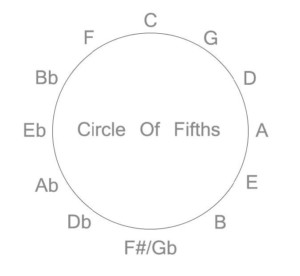
The circle of fifths is just an ordering of notes that you see in the clockwise direction. The cycle starts at C and moves upward by a perfect 5th interval each time giving us the notes C G D A E etc.
For the circle of fourths we just work around in a counterclockwise direction giving us C F Bb Eb etc.
For this exercise I would recommend working through the cycle of fifths from C to F# and the cycle of fourths from C to Gb. This will then cover all of the keys without the complication of odd sharps and flats.
So that’s the exercise. I won’t be working through any of the other keys by note in this lesson because it’s important for you to work them out for yourself. Some of you may be able to just play it straight away through every key and if that’s the case then great. But I suspect most of you will find this quite tricky or even impossible at first. So follow the steps I’ve provided and practice each one in turn until you have them sufficiently nailed. Then move on.













Very informative lesson. I can appreciate the perspective in which you conveyed this lesson
Awesome Work Marc – this goes very deep for a single lesson – if somebody really wants to learn you have given them a lot – you remain to be one of the top online instructors, period.
Wow! Loads to work on here but it’s a great lesson.
Thanks. :-)
Excellent! It will take me a while to absorb but the theory connects some dots for me !
This is a lot of info. Our folk group plays most often in G, D, or C, so I am going to concentrate on those keys. I look forward to your lessons because I know I will learn something. without having to listen to a lot of ‘entertaining’ chatter.
Hi, Mark. Loving this lesson but there doesn’t seem to be a PDF download? Or else I’m just being extra dozy.
What course is this lesson from? do you have a course on music theory?
Very, very useful lesson, not for bass player only! Applicable for other stringed, fret-board instruments !
Thank you
Hi Mark, appreciate all the great material you provide here. Question on the cycle of 5ths; why is it not presented showing sharp notes? The cycle of 4ths has its flat notes shown, but the 5ths are not treated the same way? Is it only because of the 4ths and 5ths being represented here as a circle and not individual cycles? Cheers! :)
Wow, Mark! Your bass lessons blow doors off. Thank you so much for providing them for us noobs. I’ve learned so much. Blessings to you and yours.